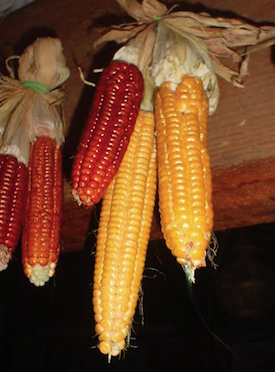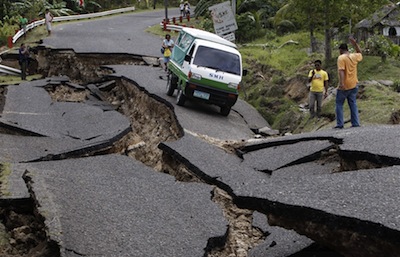
You may forward Planet Waves Monsanto Eco to your friends. They can sign up for this free environmental newsletter from Planet Waves. View this edition as a webpage. Dear Friend and Reader: Dow AgroSciences, a unit of biotech company Dow Chemical, received final approval by the U.S. Department of Agriculture for two genetically modified corn and soybean crops, Reuters reported Sept. 17. The new crops, designed to tolerate Dow's Enlist herbicide containing 2,4-D (a component of Agent Orange), will be sold as part of the branded Enlist Weed Control System.
Approval of Enlist by the USDA blatantly ignores decades of data linking 2,4-D to cancers and reproductive problems, as well as other chronic diseases. EPA memos and tables leaked in 1993 to Greenpeace document that one-fourth of manufacturers' 2,4-D samples contained toxic levels of TCDD, and that all samples contained a stew of other dioxins -- yet this data has been suppressed for decades. In addition, as far as Planet Waves' most experienced environmental researcher can tell, "No studies have been done on synergistic effects of 2,4-D and Round-up (which not only contains glyphosate but a raft of exquisitely toxic ‘inert ingredients,' one of which is linked to male sterility)." It goes without saying, but it's worth putting in black and white anyway: The new GMO corn and soybeans being approved will increase 2,4-D and Round-up use exponentially, and these poisons will be in and on the corn and beans. "The USDA approval of Enlist after such a fundamentally flawed review process is a slap in the face to farmers," said Marcia Ishii-Eiteman, senior scientist with Pesticide Action Network. "Thousands of farmers have warned USDA of the crop damage, economic losses and health risks they will face from pesticide drift, if these 2,4-D resistant seeds hit the market." GMO Wheat Found in Montana Field Drift is also a problem with pollen from GMO crops, as well as pesticides. Roughly one year after the discovery of GMO wheat in a single Oregon field, another variety of Monsanto's Roundup-resistant grain has been found in a second U.S. location in Montana, reported the Associated Press Sept. 26. The unregulated wheat was discovered on three acres at a research facility for Montana State University in Huntley July 14 -- prompting an investigation by the U.S. Department of Agriculture's Animal and Plant Health Inspection Service (APHIS). Regulators said Friday that the GMO crop has not entered commerce and that its presence evades explanation.
Flying Rivers Grounded in South America Continuing deforestation in South America has caused severe droughts, The Guardian reported Sept. 15. The depletion of trees has apparently caused the loss of the "flying rivers," travelling water vapor that brings much-needed humidity to other areas of the continent. Deter, a real-time deforestation mapping system, found that in the past year, clearing activity increased by 10 percent, reversing a two-year trend. The Flying Rivers Project, which monitors the local evapotranspiration cycle, claims Brazil "receives more rain than any other country in the world" and "has relied on hydro power for up to 90% of its energy requirements" until recently. They intend more research to better understand how the phenomenon works. Mining Corporation Sues El Salvador International mining corporation OceanaGold has sued the country of El Salvador for refusing to grant mining permission since 2006, Reuters reported Sept. 16.
Oxfam community leader Sofia Vergara said OceanaGold was "trying to divide the people without following the proper procedures." Those protesting the case cite the likelihood of water supplies for the area being tainted by the mining, which would use cyanide and arsenic, among other substances, along with large amounts of water. Water Composition Tentatively Implicated in Earthquake Prediction Researchers from Stockholm University have forged a tentative connection between chemical composition in groundwater and the probability of an impending earthquake, New Scientist revealed Sept. 21. The study, published at Nature Geoscience, explored variations in the presence of elements such as radon, which occurred prior to two consecutive earthquakes in Iceland, and proposed the tests as a possible factor in prognosis.
More evidence needs to be gathered, including "only testing in retrospect when a realistic large sample of events can be analysed fully for hits, misses and false alarms," according to seismologist Ian Main of the University of Edinburgh, U.K. That said, it's possible this correlation equates to one more reason to be concerned with the effects of hydraulic fracturing (fracking) to extract natural gas. Soon-to-Be Banned Antibiotic Pesticides Linked to Allergic Reaction Medical News Today published in its September issue "the first report of an allergic reaction to fruits treated with antibiotic pesticides used to control the growth of bacteria, fungi, and algae." Medical test results concluded that the documented allergic reaction was to streptomycin, an antibiotic applied to blueberries as a pesticide; the patient in question was a child with a history of asthma, plus allergies to penicillin and cow's milk who had an anaphylactic reaction after eating blueberry pie. This report comes just as the first steps to ban antibiotic pesticides in the U.S. will be taking effect. According to Oregon State University and other sources, as of Oct. 21, 2014, antibiotic pesticides will no longer be sanctioned for organic crops in the U.S. The European Union has banned use of streptomycin and other antibiotics as a pesticide since 2004.
Wolves in Wyoming got a temporary reprieve Sept. 23, when a federal judge restored Endangered Species Act protection for them, The New York Times reported last week. Judge Amy Berman Jackson ruled that the federal Fish and Wildlife Service was "arbitrary and capricious" when its officials accepted an inadequate and unenforceable management program proposed by the state; the plan aimed to maintain a minimum wolf population but designated them as "predators" in four-fifths of the state, where unlimited killing of the animals would be allowed. Bonnie Rice, a senior representative for the Sierra Club's Wild America campaign, told the Times, "We think the court is right to require them to develop a plan that's more science-based and doesn't treat wolves as vermin in the majority of the state." Although this ruling is good news, groups such as the Natural Resources Defense Council and Earthjustice are gearing up to ensure Wyoming's next wolf management plan gives the animals needed critical protections. Yours & truly, Amanda Painter and the ECO editorial team You may forward Planet Waves Monsanto Eco to your friends. They can sign up for this free environmental newsletter from Planet Waves. View this edition as a webpage. Planet Waves Monsanto Eco (ISSN 1933-9135) is published each Tuesday evening in Kingston, New York by Planet Waves, Inc. Publisher: Eric Francis Coppolino. Editor: Amanda Painter. Business Manager: Chelsea Bottinelli. Web Developer: Anatoly Ryzhenko. Research, Writing and Editing: Planet Waves Monsanto Eco is produced by a team consisting of Amanda Moreno, Amy Elliott, Carol van Strum, Len Wallick and Chad Woodward. Love A Libra? Pre-Order the Libra Birthday Reading Dear Friend and Reader: We've begun a new season: the Sun is in Libra and the equinox and Libra New Moon are behind us. But you still have the opportunity to pre-order the upcoming Libra Birthday reading for half the published price.
It consists of two astrology sessions and a tarot session, plus a live call-in discussion (date TBA; the discussion is recorded for those who cannot attend the live event). These conference calls have been a productive and fun way to learn about astrology and how it affects us. You also get access to last year's reading to check Eric's accuracy, and to review the past few seasons. In addition, your reading includes an extended written sign description. I invite you to take advantage of some helpful, eloquent and spot-on astrology at an incredible value -- or share it with a loved one as a birthday gift. Here is your half-price pre-sale offer. Yours & truly, To unsubscribe, click here e Wiki | Friends | Editors | Contact Us Copyright © 2013 by Planet Waves, Inc. All Rights Reserved. Other copyrights may apply. Some images used under Fair Use or Share Alike attribution. |





